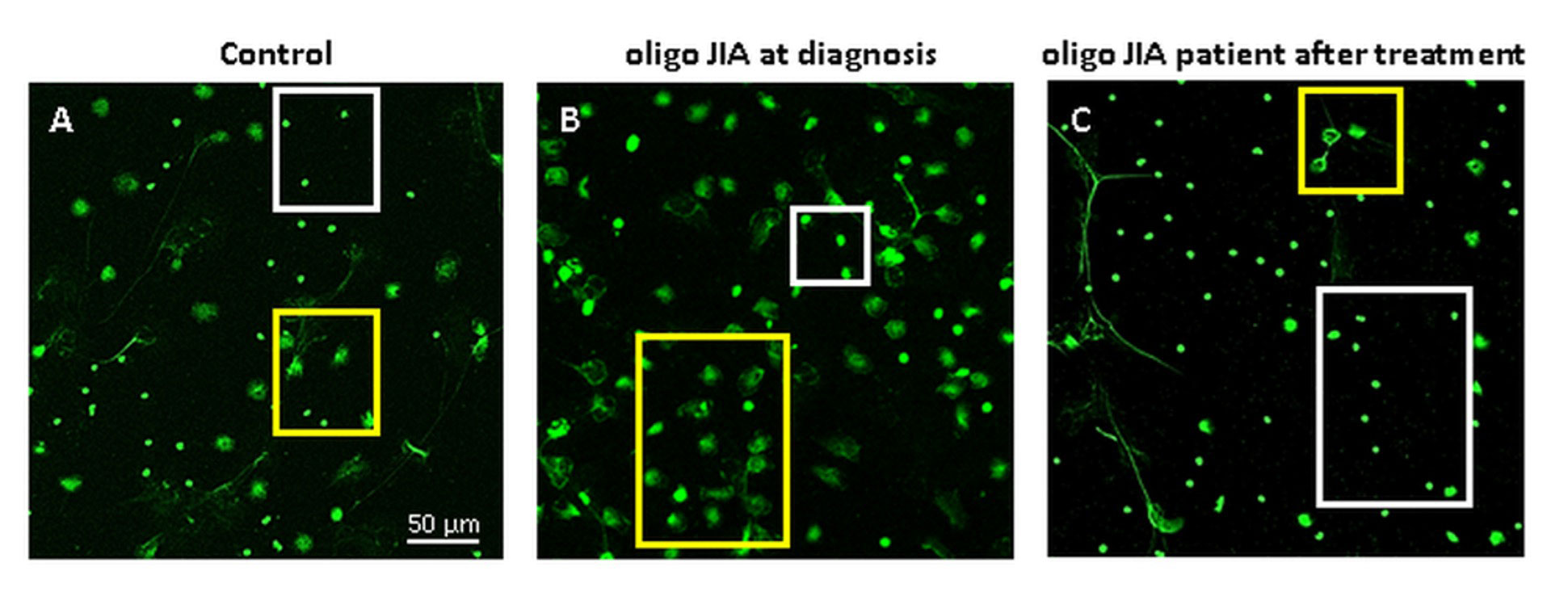Session Information
Session Type: Poster Session B
Session Time: 9:00AM-10:30AM
Background/Purpose: Juvenile idiopathic arthritis (JIA) is the most common chronic rheumatic disease in children, causing significant morbidity. Despite the dramatic improvement in treatment, many patients do not achieve complete remission, and biomarkers for subclinical disease, flares, and response to treatment are lacking. Neutrophils and neutrophil extracellular traps (NETs) were revealed to partake in the pathogenesis of autoimmune and inflammatory conditions, but their role in JIA pathogenesis and as biomarkers for JIA disease activity are largely unexplored. In this study, we aimed to characterize the neutrophil enzymatic activity and NETs in oligoarticular and polyarticular JIA and explored its association with disease activity.
Methods: Neutrophils from 7 patients with oligoarticular and RF negative polyarticular JIA were isolated at the time of diagnosis and after glucocorticoid intraarticular injection with or without DMARD treatment. Enzymatic activity of neutrophil granular enzymes was monitored by colorimetry, while NET formation was assessed using a confocal fluorescence microscope.
Results: In oligoarticular JIA patients (n=4), all disease activity parameters and neutrophil function-related parameters decreased following intraarticular steroid injection. However, only three parameters exhibited statistically significant decline, including Physician Global Assessment (PhGA), Juvenile Activity Disease Activity Score-10 (JADAS-10), and clinical JADAS-10 (cJADAS-10). Importantly, NET formation was strongly positively correlated with the cJADAS-10 at all time points (R=0.93, p=0.007). In polyarticular JIA patients (n=3), neither clinical disease activity parameters, the CRP, or the neutrophil function-related parameters showed consistent and significant decreases after steroid injections. Similarly, there no significant correlation was found between NETs formation and cJADAS-10 in polyarticular JIA patients.
Conclusion: This is the first study exploring the link between NETs formation and JIA activity. In this pilot study, we demonstrated a statistically significant linear correlation between cJADAS-10 and NETs formation in oligoarticular but not in polyarticular JIA patients. Hence, we suggest that NETs might play a role in JIA activity and may serve as a putative biomarker for treatment response. Further work is needed to validate these initial results and determine dynamics of NETosis in JIA.
To cite this abstract in AMA style:
Heshin-Bekenstein M, Baron S, Schulert G, Shusterman A, Shukrun R, Binenbaum Y, Elhasid R. Neutrophils Extracellular Traps Formation May Serve as a Biomarker for Disease Activity in Oligoarticular Juvenile Idiopathic Arthritis [abstract]. Arthritis Rheumatol. 2022; 74 (suppl 9). https://acrabstracts.org/abstract/neutrophils-extracellular-traps-formation-may-serve-as-a-biomarker-for-disease-activity-in-oligoarticular-juvenile-idiopathic-arthritis/. Accessed .« Back to ACR Convergence 2022
ACR Meeting Abstracts - https://acrabstracts.org/abstract/neutrophils-extracellular-traps-formation-may-serve-as-a-biomarker-for-disease-activity-in-oligoarticular-juvenile-idiopathic-arthritis/

